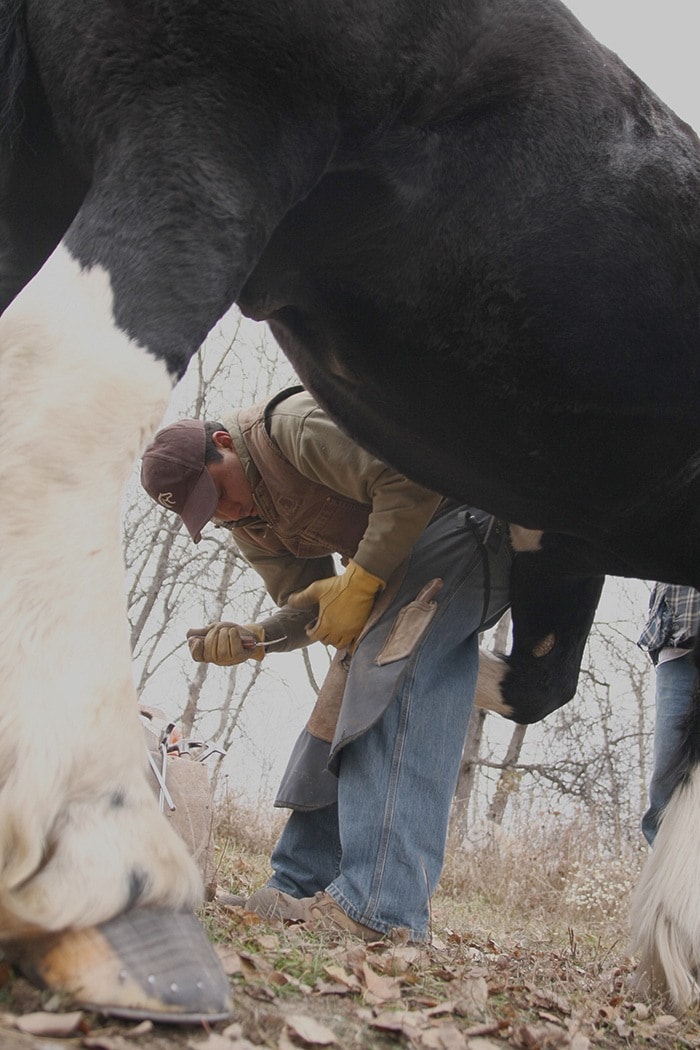There are snowflakes drifting about and the thermometer is below zero, but Jake Giguere is smiling.
Giguere is a farrier and there’s nothing else he’d rather do.
“The horses,” he said was the initial reason he became a farrier.
“I really enjoy the horses and the people.”
Giguere, 30, initially entered the world of horses as a guide, but a need to tend to the hooves of the horses on the trail gave Giguere a bit of an introduction to the farrier trade and he discovered he had a knack for it.
After a few years, Giguere said he felt he was at a crossroads.
As a guide, the work is seasonal, and Giguere said he was looking around trying to figure out what his next move should be.
He looked back on happy moments in his life and the one common theme was being around horses.
“So I figured I needed to find a job to be around them,” he said as he reached for a hoof knife.
Once he decided he wanted to be a farrier Giguere headed to California where he took a 2.5 month course at the Pacific Coast Horseshoeing School in Plymouth, California.
He pares back the frog, a pad of dead tissue on the bottom of the hoof, then clears the dirt out of the sulcus, a groove, on either side of the frog to minimize the risk of the horse contracting thrush, an infection of the hoof.
Being a farrier is not exactly the safest of professions, and rookies can make many mistakes.
“Not stretching,” he says with a laugh, but he’s serious because he spent most of this day hunched over to tend to the hooves of more than 20 trail horses.
The owner of the horses, Mike Danielson appreciates Giguere’s skill.
“He does an awesome job and he’s good with my horses,” Danielson, owner of Little Dease Ventures, said.
While reaching for a hoof clipper, Giguere adds farriers also need to be able to read and understand horses and know how to interact with them.
“They [apprentice farriers] don’t present themselves to the horse properly,” he said.
“You need good horsemanship skills.”
With the hoof trimmed back, Giguere reaches for a long file and smooths out the edges, then moves around to the next hoof.
Giguere is in demand, a testament to his skill, with clients as far away as California, in addition to the Bulkley Valley and the Cariboo.
Another aspect of horseshoeing Giguere appreciates are the ongoing learning opportunities.
In addition to learning on the job and from watching experienced farriers on subtle differences in the fitting of horseshoes on trail horses as opposed to rodeo horses or dressage horses, Giguere attends yearly conferences to learn more about the art of being a farrier.
This year Giguere is up for the Rising Shoeing Star, a recognition of just how talented a farrier he is.
“I was humbled when I got the call,” he said.
Although Giguere makes quick work of tending to the hooves, he admits there really is nothing easy about being a farrier.
“It’s a hard job, it’s not easy,” he said.
“You have to be mentally focused everyday, if not you’re going to get hurt.”
Despite the difficulty and the risk of being stepped on or kicked, Giguere has no intention of switching careers.
“I’m passionate about it,” Giguere said.
“That’s why I’m in it.”
